CHAPTER 9
ULTRA RAPID NEGATIVE EMULSION
contents below showing ultra rapid panchromatic negative silver gelatine emulsions which in this book is chapter 9.
it is here given how to make rapid negative photographic silver based emulsion and how to gold and sulphur sensitize.
also how panchromatic liquid light sensitive photographic silver gelatine emulsions are made. how they are dosed with
erythrosine, pinaverdol, pinacyanol, cyanine and many other dyes the stain the silver grain.
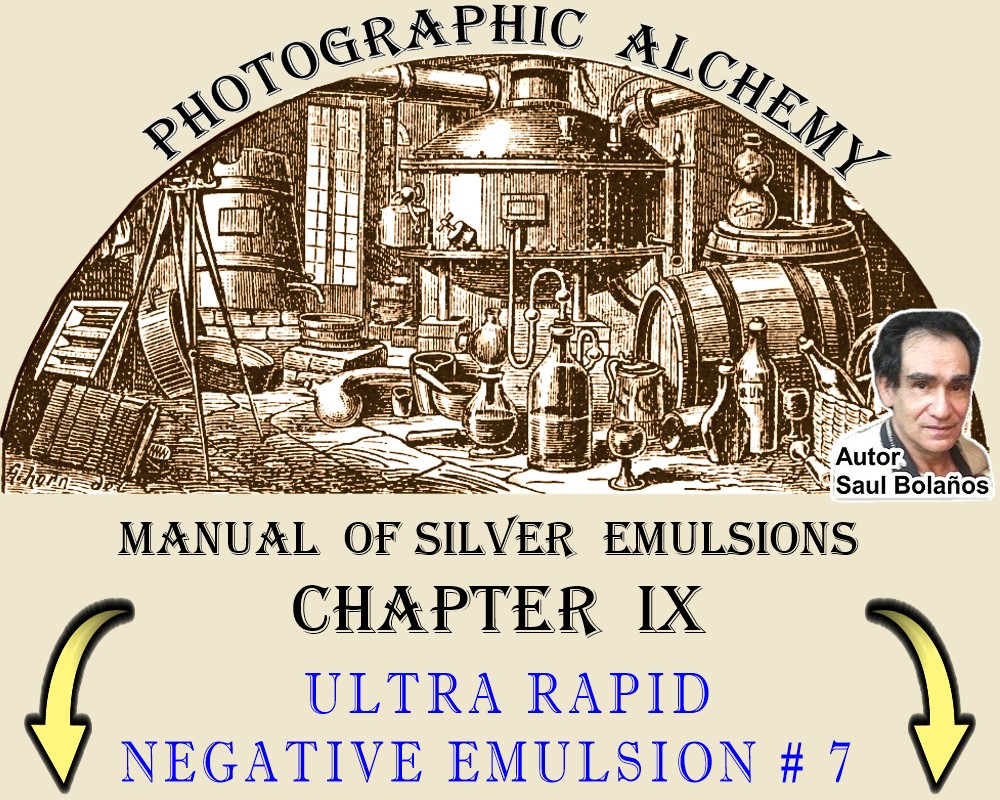

A "Secret" high speed Negative emulsion like my formula given here was used by the german air force in
world war II, with 2 variants. 1. the silver was precipitated during 30 minutes
(instead of 20 minutes) to get a bigger more sensitive to light silver grain of about ISO
64, and 2. was further made more sensitive by adding a gold salt, (see
below) which sensitized it to about ISO 125.
 ABOUT MY EMULSION BELOW:
ISO: 32-64
ABOUT MY EMULSION BELOW:
ISO: 32-64
How You Can make:
The Most ULTRA RAPID NEGATIVE EMULSION # 7
IMPORTANT NOTES:
In The History Of Gelatine Silver Emulsions
Without "GOLD" OR "SUPER-DYE
SENSITIZATION"
THIS IS THE HIGHEST EMULSION SPEED EVER
ATTAINED BY THE AGFA OR KODAK EMULSION WORKERS;
FOLLOWING ARE THE HIGHLY REGARDED SECRETS:
This emulsion (neutral “without
ammonia") furnishes extreme resolution, extraordinary high contrast and unequalled fine grain, (grainless
enlargements 10 x) These are Due to:
1. The Special precipitation Technique
in which the grains are not allowed
to clump together, thus: after adding 20 % Ag in advance:
the remaining 80 ml of the silver is added at the rate of 1 ml every 15 seconds during 20 minutes. This 1 ml of
silver is dropped slowly in no Less than 10 seconds into salts sol while at the same time agitating continuously all
throughout the 20 min precipitation time.
if the 1 ml silver was added brutally every 15 seconds, the grain and
resolution would be
fine but not “extremely fine”
2. Ammonia
during precipitation produces excellent high contrast negative
and positive emulsions, (but grains tend to clump together) this one of the reasons why ammoniacal emulsion of this
speed for negative work are inferior to Emulsion # 7 as to contrast,
fineness of grain and resolution.
Rapid, clean,
negative emulsions require a great deal of attention to a legion of small details. To make a good negative emulsion
at least 3 fundamental conditions have to be met, these are:
1. A good formula
2. A good Procedure.
3. A good gelatine.
I have worked out this formula and have tested the procedure in many different variations.
Although not being the
fastest and the best of the of my Negative emulsions, This is a good formula and a good “intelligent”
procedure and by far the easiest of the “hand made” (without machines) negative emulsions.
FOG IS "The # 1 trouble in Emulsion Manufacture"
this may be
caused many factors, the most common being:
1. Overexposure to “safe” light, during mixing, coating, or bad storage
of finished emulsion.
2. The use of a bad gelatine loaded with reducing agents such as aldehydes.
Photo grade inert “oxidized” type of gelatine is desirable, because in the process of its purification,
all fogging agents have been removed. The same may be said of “ food grade” gelatine,
which if in Leaf
Form and oxidized, can provide an excellent clean emulsion. With this formula;
-Inert “oxidized” either
“photo grade” or “Food Grade,” gelatine requires to be sulphur
sensitized to obtain high speed and strong blacks.

Analysis of Formula and Important Notes
In this formula the sulphur sensitizer in the form of thiosulphate has been added to solution D, (refer to
formula). To raise the ph and obtain more speed Sodium Carbonate has been included as well, the egg albumen in D, is a fog restrainer, it prolongs second
ripening time, but it increases contrast yielding cleaner and denser plates.
To prepare the albumen:
mix 100 ml of egg white with 100 ml of water and whip
completely, filter foam off, and use the filtrate. Prepare fresh every time before use.
To prepare the thiosulphate,
just mix and use fresh or certainly not older
than 3 weeks. A thiosulphate solution 6 months old, will give an emulsion that requires about 25 % more second
ripening time to attain the speed imparted by a fresh solution. If this variable is not eliminated, there will be
trouble when changing from a fresh to a old sulphur solution.
Sensitizer D, is added right after washing and re-melting emulsion, at the
beginning of the second or “chemical” ripening. By this time it is assumed that you have made other much
easier to make positive emulsion given in this book, and after testing your gelatine with
my Ammonia Emulsion # 1, you know by now what type of gelatine you are using, and wheatear it is “inert” or “active“. Directions have already been given as to how to divide one same washed
emulsions into small lots for testing during second ripening. If you have any doubts about the gelatine to be
used.
simply make 2 batches of emulsion.
One with sensitizer and another without it. For the first batch without sensitizer
D, After washing, melting and heating at 55c, (131 f) to examine the progress of second ripening, take samples
of the emulsion on strips of watercolor paper. In 2 hours at 55c, there should be no fog, whites should be
clean when developed in Dektol or D72, 2min 20c (68f), take another test at 3hr/55c. with a good active gelatine by
this time Blacks should be strong , with little or no fog at all. If there is fog in 2 hours/55c , the gelatine is no
good or emulsion was fogged during mixing, coating or processing.

MY OLD SECRET FORMULA:
Note that “high speed” emulsions Like this one if coated with a
brush on highly “textures” paper, can cause a little fog, due to the “stress” or friction left
by the brush on the hyper sensitive silver grain. The same “foggy” emulsion coated by gently flowing onto a
glass plate can furnish absolutely glass clear whites with no fog.
The other or second testing batch of emulsion should
be made with inclusion of sensitizer D, and after washing , a second ripening time for 3 hr/55c should be given In which case a good inert gelatine will provide
a high speed clean negative emulsion for coating glass plates. Note: that if coated on paper for positive work this
emulsion yields low contrast, but not when used in the camera for recording scenes in nature which are much brighter
than when printed from negatives.
Note also that the emulsion when coated on paper (seen by reflected light) will appear a lot more
dense, with stronger blacks than when seen by transmitted light (as on glass plates) it follows then that a paper strip
exposed in camera usually shows 100 % more speed than when same emulsion is coated on glass and “printing”
density judge by transmitted light .
The final speed of this excellent formula will depend exactly on the amount of time it is allowed to second ripen until it
shows the first traces of “tolerable” fog.
Note also that after stabilization, the free bromide will combine with spurs of free silver, this will reduce
slight “spurs” of acquired ripening fog but at the same time speed may drop as much as 33 %. Due to the
fact that I know the gelatine I use, and because I made this very same emulsion many times, I take this formula to a second ripening of 4. 5 hours/55c, which time is the border of fog and at which I obtain a speed of ASA 32 coated on glass plates. With very good contrast and density.
To retain maximum
emulsion speed I do not stabilize it because I usually use the coated plates in less than 1 month, in that storing
time, kept under 25c, no objectionable amount of fog ensues.
1. The amount of Potassium Iodide
in the formula is 5 % of the weight of the Silver Nitrate, this assures anti halation on glass plates, but above all it
allows a longer second ripening time with no fog to obtain higher speed. Without the Iodide, it is impossible to obtain
high speed because emulsion would fog almost immediately on melting after washing.
Silver iodide being more difficult
to reduce, (than silver bromide) keeps the whites purer for a longer time during development, in this way iodide also
imparts more speed and helps contrast. Above 5 % in pot. Iodide, emulsion takes much longer to fix.
2. The excess of halide over the
silver is about 70%, this promotes grain growth is much less time during First Ripening, ( than only 10 % excess
for example, which takes longer to arrive at same speed)
3. The concentration of precipitants is a normal
10-12 %, which shortens first ripening time greatly, although giving a good density, a 10 % precipitants do not produce
high density grains with great covering power, as do diluted precipitants at 5 % concentration of other my speed
formulas, the density on the glass plates is very good however.
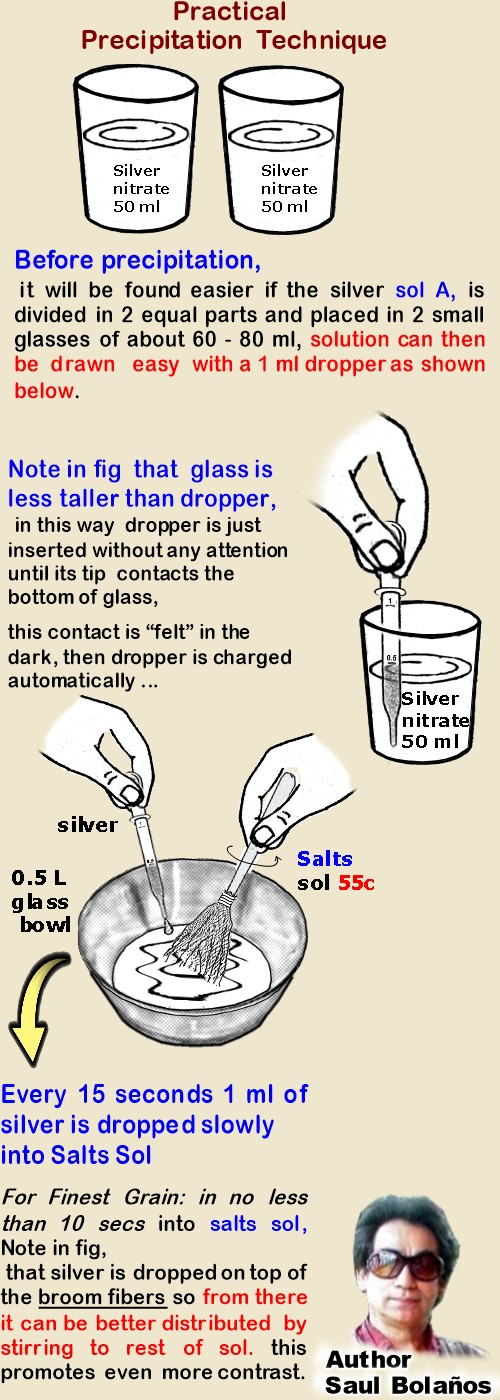 4. Concentration of gelatine during
precipitation is (1.25%) to induce grain growth rapidly. It is a low “safe” concentration without producing
coarse grain and in combination with the slow silver addition rate is the great SECRET to produce high contrast high
density emulsions without the use of ammonia.
4. Concentration of gelatine during
precipitation is (1.25%) to induce grain growth rapidly. It is a low “safe” concentration without producing
coarse grain and in combination with the slow silver addition rate is the great SECRET to produce high contrast high
density emulsions without the use of ammonia.
If gelatine content is raised in sol A, and the silver sol added rapidly
in less than than 3 minutes for example, the result will be a very poor emulsion, very low contrast, and much reduced
speed and a useless covering power on glass plates.
5. The contrast will also greatly
depend on the agitation during mixing, which should be continuous without any interruption all throughout the first 20
minutes, stirring also keeps large heavy grains from dropping to the bottom of the mixing vessel.
It is to be
remembered and realized that this is not a positive emulsion where grains are kept small. If emulsion is not agitated
often,
during mixing, second ripening and coating, the giant grains will sink to the bottom of the vessel, If coated without
gently stirring every 10 minutes at least, silver would be lacking on the coated film, yielding plates of lower
contrast and sensitivity.
6. The rate of addition of the
silver also influences contrast and density building which means covering power on the glass plate, a continuous
falling stream of silver results in more contrast than adding it in small portions as given.
But an advantage of adding
the silver in small portions as given, is a wider latitude of exposure and an easier mode of preparation for beginners
who do not possess adequate mixing machinery and who can no easily keep conditions without variables.
The addition of
the silver at room temp instead of heating it to 55c, is another blessing for amateur labs. It means less spilling and
staining of hands or clothes due to difficult manipulations under extremely subdued safelight illumination as
absolutely required for negative emulsion making. It also means that emulsion will be easier to reproduce from batch to
batch, because the temp of silver emulsion will not be a much critical variable.
As said before, this is an
“intelligent” formula it is so for many other reasons that there is no space to treat here.
7. precipitation time of say 30 minutes instead of 20 minutes, will produce an emulsion of a higher
speed with a lower contrast. But if mixing time is changed, other conditions may have to be adjusted accordingly
because a lot depends on the mode of mixing, shape of dishes.
temperature and amount of gelatine. In a 30 min.
precipitation time, for example at 55c, more water will evaporate out of the mixing vessel than in 20 min. This change
in the water content of the vessel, will have an influence on grain growth, and also on the amount of gelatine that
needs to be added in order to set it into a thick firm mass for washing.
8. notice that 20 % of the silver solution is added
to the salts solution in advance, this action builds a nucleus or first colony of first born grains where the rest of
silver added later, will merge and conglomerate with. This results in grains with a tendency to fog (if first ripening
is too prolonged) but of considerable more light sensitivity, than if all of the silver is added all in succession in
one single step.
The time lapse at which the first population or nucleus of first generation silver grain built in
the first instance is allowed to grow before the addition of the rest of the silver is resumed; has certainly a great
influence on speed and contrast. For consistency Iwait no more than 1 minute before adding the rest of the remaining
silver. If a more rapid emulsion is wanted, then a longer waiting period would have to be enforced, but then we are
talking about another emulsion, not the present one.
9. Temperature of mixing has important consequences;
to name a few: If salts vessel is not well pre-heated and remains lower than the prescribed 55c, before precipitation,
or temperature drops for any reason during the progress of precipitation, final speed of emulsion will be very low, at
a lower 50c for example, not even ASA 12 can be expected. On the other hand if heating plate goes wild to around 75c,
speed may double maybe to ASA 50 with a drop in contrast and possibly fog if mixing time is not adjusted with precision
accordingly to the higher temp.
Another consequence again is the water evaporating rate of the emulsion which may thicken faster at higher temps,
affecting the character of final emulsion. Needless to say this formula was “crafted” considering other
factors too exhausting to deal here. It is advised, if good results are to be obtained in first trials not to vary this
formula in any way or form.
10. Making other Quantities of Emulsion than the
quantities given: quantities may be varied but reactants must be kept in same proportion in relation to each other, and
if results are to be reproduced consistently: do not vary the temperature and precipitation time, even if 100 liters of
emulsion are being made, 20 minutes will be precipitation time and 55c the ripening temperature, those two remain
constant for any quantity of emulsion
11. Ag/Gel Ratio For better covering power,
sharpness and maximum speed, The more the silver content in proportion to gel, the better. There is a limit of course
due to mechanics. Gel content can not be further reduced in this formula because emulsion will not set firmly for
shredding and washing.
12.WASHING
Excess of Soluble “Free” Bromide, full directions have already been given on how to wash ammonia and
neutral emulsions like this one (see wash chapter 4)
 This negative
emulsion has about 70 % excess of potassium bromide, this amount is a considerable great excess, and will not all wash
out in 4 changes ( not even 8 changes) of 2 liters of ice water.
This negative
emulsion has about 70 % excess of potassium bromide, this amount is a considerable great excess, and will not all wash
out in 4 changes ( not even 8 changes) of 2 liters of ice water.
Now supposing “all” of this free bromide
was eliminated by “over washing”, in this case, if no extra free bromide is added to emulsion at the start
of second ripening, there would be formation of fog very soon. Emulsion will not be clean because in
“alkaline” development, the silver ions now “in excess over bromide ions” would be reduced in
the highlights.
Now, with a normal washing of 20 -40 min, as given, Great part of this excess of “free bromide” will be
available after washing during second ripening, therefore it is not necessary to add more free bromide at start of
chemical ripening to check fog.
The amount of free bromide brought by washed emulsion, will have some influence on the
amount of time necessary to attain final speed during chemical or second ripening.
After what has been said, it will be
evident, that for consistency from one emulsion batch to another it is necessary to always have same method of
shredding, same washing time, same amount of water and temperature, and same plan of agitation. This washing cycle
protocol must be strictly adhered to. Minimum wash time should not be less than 4 changes of: 5 min / 2 liters each,
for a total wash time of 20 min.
 For the purpose of Ortho-Cromatization with
Erythrosine, the silver ions must be almost dominant, in another words the emulsion must be washed to the
border of fog to get rid of most of all its free bromide.
For the purpose of Ortho-Cromatization with
Erythrosine, the silver ions must be almost dominant, in another words the emulsion must be washed to the
border of fog to get rid of most of all its free bromide.
Otherwise great amounts of free bromides will interfere and
make the spectral sensitization not as effective.
The amount of optimum washing time to this effect must be found by
trial and error.
Emulsions made by the Ammonia method with the speed of the present emulsion, have less contrast, are
less clean, required much longer washing times, and all conditions being equal, have less shelf life on storage, but
are easier to sensitize with erytrosine.
13. Second Ripening Temperature official second
ripening time and temperature is 3hr / 55c,
but if second ripening temp is lowered to 45c, and at the same time
ripening time prolonged to 5 hours,
(in 6 hours fog may be intolerable) this variable will results in a almost similar
speed but with more contrast than ripening at 3 hrs/ 55c
14. Gel concentration during second
ripening with the normal 7.5-10% gel concentration that a correctly washed emulsion will have right after
washing and at the start of second ripening, much more contrast and speed can be obtained than with 5% gel
concentration.
For this reason it is is important to be consistent during washing by not allowing emulsion to absorb
too much water and drop to a 5% gel concentration on re-melting. This can be easily regulated by keeping wash water
very cold ( not above 5c) as directed. (see further explicit instructions on this matter below)
15. Emulsion Volume after washing on Remelting
will be between 150ml (10% gel) and 200 ml (7.5 % gel) + 35 ml of sensitizer that must be added, which will thin or
dilute emulsion to about 185 ml (8% gel) or 235 ml (6.4% gel) As seen addition of sensitizer D, may dilute emulsion
considerably if emulsion absorbed too much water during washing,
In this case, condensation of the emulsion is
necessary, to effect this, before the start of second ripening: after thoroughly remelting washed emulsion inside a
Wide Mouth Dish, transfer to ripening jar, this jar should be previously marked with a few lines corresponding to
emulsion volumes, one mark to a 150 ml level, another to 175 ml and a third line to a 200 ml level.
(use water to
pre-mark it by normal room lights) Now to evaporate excess water and to concentrate gel content at the same time, -do
not place lid on ripening vessel sitting in water bath at 55c, and stir frequently. This action will condense it to any
desired level during remaining heating time.
At any time during the course of ripening when emulsion has attained the desired volume by
condensation, -corresponding to an 8 -10 % gel concentration which is a volume of 190 and 150 ml respectively ( known
by examining pre-marked lines on emulsion vessel)
At this time then, the lid is placed on vessel to prevent further
escape of water from emulsion maintaining thus the acquired gel concentration; the rest of ripening time is continued
with the vessel capped, stirring frequently throughout all the ripening time.
( about 15 seconds every 10 minutes) at
the end of second ripening vol final should be adjusted to be not above 200 ml which is 7.5 % gel concentration.
Below 7.5% gel conc. emulsion may be too thin for coating and what is worse when coating it on glass plates the large
heavy grain may sink to bottom of the glass plate if liquid phase of coated emulsion is too long
(more than 3-5 min)
Needless to say, during coating (with any gel concentration) of this emulsion, it must be caused to
firmly set as soon as possible, by chilling the large leveled glass plate in ice water before coating. (see coating
35mm glass plates)
 STEPS DURING
PRECIPITATION
STEPS DURING
PRECIPITATION
and Washing of Emulsion
For all steps in Making of this emulsion, Safelights (it can be more than one) should be dark red.
For easy seeing,
these should be placed in a manner that they throw their full light directly on the clocks or timers and the silver
nitrate glasses;
-But the place where the mixing of emulsion is taken place, that is the bowl with the melted salts
solution,
should be shaded by any means As shown in fig.
Shading in same manner of mixed emulsion should be continued
for all subsequent remaining steps to avoid any Safelight fog.
STEPS IN SECOND RIPENING
AFTER WASHING EMULSION
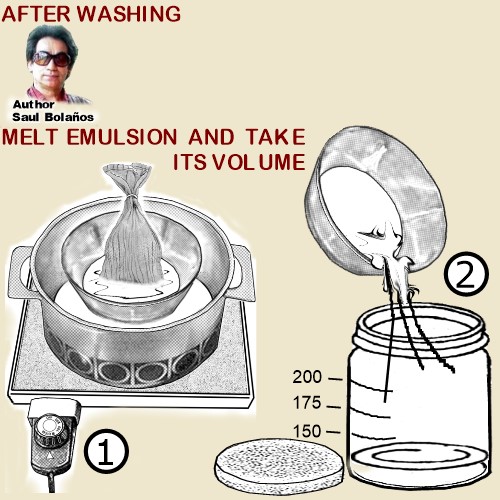
1. After washing and draining place bag in contact
with the empty dish heated on a hot water bath ( 55 c) so emulsion on melting will flow into it.
Now transfer fluid
emulsion...
2. Emulsion Vol after washing
After melting, -Emulsion volume will be between 150 ml (10 % gel) and 200 ml ( 7.5 % gel) +
35 ml of sensitizer that must be added, will thin or dilute emulsion to about 185 ml
(8 % gel) or 235 ml (6.4 % gel)
transfer now liquid washed emulsion into a 300-500 ml vol glass jar previously marked
with waterproof ink to 150, 175, and 200 ml volume. as shown in fig, Jar must have a cap. Next add the 35 ml of
sensitizer D,
Now emulsion in jar will be ripened at 55c, if necessary to condense: do not place cap on as shown
next.
 3. If volume after adding D, is not more
than 170 ml corresponding to about 9 % gel concentration; - place lid on emulsion vessel and continue ripening for 3
hours at 55c , stirring frequently throughout all the ripening time. ( about 15 seconds every 10 minutes)
3. If volume after adding D, is not more
than 170 ml corresponding to about 9 % gel concentration; - place lid on emulsion vessel and continue ripening for 3
hours at 55c , stirring frequently throughout all the ripening time. ( about 15 seconds every 10 minutes)
4. If volume after adding D, is
above 170 ml, do not place lid on vessel and apply heat.
Ripening time starts counting as soon as emulsion reaches 55c, Agitate often so Water will escape and emulsion will
condense to required volum of about 170 ml -when it does: cap vessel until remaining ripening time is completed. stir
often throughout all of the ripening time.
At the end of 3 hr, 55c (total heat time) add
finals; stabilizer E, and optional F & G. Final Vol should be adjusted to be not above 200 ml which is 7.5 %
gel concentration.
Below 7.5% gel conc. emulsion may be too thin for coating. For coating see “coating 35 mm
glass plates “
NOTES:
1. During the course of ripening to examine the progress of speed, contrast and fog levels on emulsion;
about every 45 min, coat ( 3 coats) strips of watercolor paper rapidly, dry and develope. (this step takes about
30min)
2. Alternatively washed un-ripened emulsion may be divided in small lots, each placed in separate containers, and each lot submitted
separately to variable ripening times, as described for my ammonia emulsion # 1 which see.
3. For more speed precipitate and first ripen at 60c
(instead of 55c) second ripening time may have to be shortened, only a test can show how much.
Next: “Ortho” and “Pancromatization” also: Gold Sensitization.
And Spectral Sensitization of Emulsion # 7 / (Coloring with Dyes)
Erythrosine
is an acid dye (best with ammonia emulsions)
used to increase the sensitivity of the emulsion to “see” green and yellow light. Good for portraits and
landscape work, Green foliage and vegetation for example will impress the plate, printing with a lighter tone on the
positive. Its main advantage is that it does not sensitize into the dark orange and red,
so emulsion can be safely
handled under Red Light providing exposure is not too long. It is the all time favorite, and above all: “It is easy to obtain” Erythrosine Extra Bluish is a good type
Color Sensitization by Bathing The strongest dye sensitization is obtained when
the dye is not added directly to the emulsion, but instead by bathing the coated dry plate in a dye sol or bath.
This
applies to Pinaverdol, Pinacyanol and all of the dyes used for color sensitizing. With
this method, by bathing plates, in the case of Erythrosine, it does not matter much
whether the emulsion was made by the ammonia process ( favorable for staining with this dye if added directly to
emulsion) Or if it has been completely freed of excess bromide or if it has great amounts of iodide ( both of these may
inhibit the dye from staining the grain.
Precautions During Bathing Plates with Dyes
Applies to “ all “ color sensitizing dyes known:
1.To avoid fog & damage use solutions at 20c or
below
2. Use glass or stainless steel easy to clean
dishes,
3. Immerse plate completely under sol
4. Rock plate continuously when immersed in any
bath
5. Too much ammonia may cause fog, but it has to be replenished, as
it evaporates out of the solution, it is cheap, best to renew after being used a few times.
6. For rapid drying, Immerse in Ethyl alcohol after dye bath, until emulsion
feels hard, (2-3min) Dry in total darkness as quickly as possible.(in less than 4 hours) standing plates on vertical
position preferably under cold air (see fig below) uneven drying may cause uneven sensitivity according to parts on
plate that dried first.
7. Emulsion must be clean working, Second Ripening must be stopped way before
the first traces of fog start to show. If not Ammonia may fog emulsion.
immerse dry plate 2 min in this Fore bath under 20c of:
Distilled water..................................200 ml
Strongest Ammonia........................... 3 ml
transfer now for 3 minutes to:
Distilled water............................. 200 ml
Strongest Ammonia.............................3 ml
Stock Sol Erythrosine I: 500 ........10 ml
CAPACITY:
discard after 6 plates size 4 x 5 inches or
equivalent area. After staining, Rinse in 6 changes of cold water (1- 2 min) to remove excess of dye and dry.
Handle plate only by the edges, If there is damage to emulsion, add 50 % Ethyl Alcohol to both fore bath and dye bat
& increase bath time + 50 %. Shelf life of stained plate: about 3-6 months. Without the ammonia, shelf life can be
prolonged to about 1 year but sensitizing action is reduced. Actual Shelf life depends on how clean emulsion is &
in storage conditions.
If there is fog, and it is certain is not safelight fog; reduce or suppress ammonia
entirely, (emulsion is probably over ripened or shelf life of coated plate is over) If ammonia is suppressed, use a 3
min plain cold water fore-bath instead, use this to get rid of excess of bromide or Salicylic acid, ( if these were
added to emulsion, the first as stabilizer and the second as Antiseptic.)
For maximum marked action on greens expose erythrosine plate with yellow
filter in front of lens to depress the natural “extra blue and UV sensitivity” of the silver grain.
Exposure may have to be increased according to yellow filter factor.
Dyes added directly to the Emulsion.
Pinacyanol is not hard to obtain, it is a basic (alkaline) dye, it sensitizes for red, now if the silver grain is stained to see green and yellow as well as red,
it is termed “panchromatic” it sees and differentiates the colors in nature as the human eyes sees them.
The sensitizing action of “acid” Erythrosine may be strongly reduced when used in combination with
“basic” Pinacyanol That is why these two dyes are not normally used together for making panchromatic
emulsions.(this field still a subject for much research)
But it is standard practice to combine Pinacyanol with Pinaverdol (instead of erythrosine) for making Panchromatic
emulsions as given below.
These last two are preferred for neutral non ammoniacal emulsions, (like # 7) because coated
emulsion has a longer shelf life without fog.(than emulsion with higher ph) Pinaverdol
alone (instead of erythrosine) can be used for Ortocromatization
(sensitizing for green and yellow only) see dosage also further below. Pinaverdol may
not be so easy to obtain. Instead of Pinaverdol, Orthochrome T, or Pinachrome ( but not the “blue”
or the “violet” Pinachrome) can be used all by themselves or combined with Pinacyanol, and in same proportions and also the stock Dye sol prepared in same manner as given
for Pinaverdol below.
 Dry stained Plates in total darkness
Dry stained Plates in total darkness
and as soon as possible
with cold air.
Erythrosine
Is a red dye
very easy to get it is used in microscopy and as a food dye.
That is
to color food products
in most countries of the world.
Pinacyanol Iodide formula:
1,1’-diethyl-2, 2’- carbocyanine Iodide (Basic/ also known as Sensitol Red) Pinacyanol chloride is better (more soluble) Pinacyanol
“blue” is also a Red sensitizer and it can also be used. does not sensitize for green, (green
safelight can be used)
Pinaverdol Iodide formula:
1, 1‘, 6 - trimethylisocyanine Iodide
(basic/ was also known as sensitol green) sensitizes to yellow and green light, can be used in the emulsion in
combination with Pinacyanol to make it fully panchromatic. Its action is similar to
Orthochrome T, but it is stronger in the blue green region.
Orthochrome T formula:
p-toluquinaldinequinolinmethylcyanin
(basic / ) increases sensitivity to green and yellow wavelengths.
Use Nitrobenzimidazole instead of Potassium Bromide (kbr) for stabilizing color sensitized emulsions, it is known that kbr, depresses the color sensitizing action of the dye added, but not the Nitrobenzimidazole. See Chapter: “Emulsion Problems and solutions” for preparing a 0.1% sol of Nitrobenzimidazole. If the Nitrobenzimidazole is not available, do not stabilize, but arrest ripening way before the first traces of fog.
PANCROMATIZATION:
Dyes added Directly to Emulsion
Negative Emulsion # 7, because it is “neutral” (non ammoniacal) is best color sensitized with Pinaverdol
(for green, yellow and orange) in combination with Pinacyanol (for dark orange and red) Add the dye at the end of
Second Ripening once emulsion attained its final speed, note that dyes have an stabilizing action and may inhibit
further ripening,
Add dyes when emulsion is termed: “finished“ but before the Chrome Alum
or any stabilizer or acid is added. Prepare stock solutions of the dyes each in its own separate bottle of course. The
stock solutions keep indefinitely, enclosed inside well caped “ glass bottles” and kept in the dark.
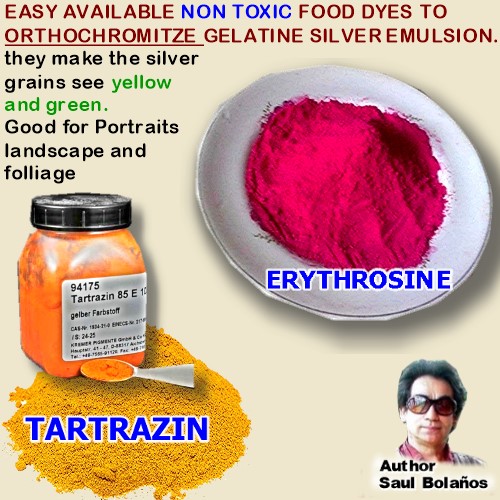 Dosages per every 200 ml of
Emulsion
Dosages per every 200 ml of
Emulsion
Stock Solution: Pinaverdol ............1 gm
Methyl Alcohol ...............................1000 ml
of the above stock sol add only: ... .2 ml
Digest emulsion for 5 min at 45-50c
and add:
Stock Solution: Pinacyanol ............ 1 gm
Methyl alcohol............................ .2000 ml
of the above stock sol add only ...... 2 ml
Notes: dosages can be increased up to 50%, if only the
Pinaverdol is added, emulsion can be handled under dark red light and is well
sensitized for landscape and portrait work
(like erythrosine) to see green,
yellow and
orange light.
If also pinacyanol is added, silver is sensitized to see dark orange and red, handle
in total darkness no darkroom light will be safe then.
extremely dark green light for a few seconds only
"BATHING" Plates with the “ Isocyanine “ Dyes
Baths below apply to all emulsion (ammoniacal or neutral) for color sensitizing plates when dye is not added directly
to emulsion. Use Dye stock sols already given for adding directly to emulsions. Follow bathing directions given earlier
for Erythrosine Dye Baths, bath time:2 min / 18-20c (Ammonia fore-bath may be used, but with Pinacyanol, plate shelf
life is much reduced.)
PINAVERDOL sensitizes to yellow green
& orange.
Very suitable for Landscape and portrait work. Note color action to daylight is similar to Erythrosine, but is stronger
to artificial light and ordinary incandescent tungsten bulbs.
Working solution:
Pinaverdol Stock dye sol ( as already given) .........0.5 ml
Distilled water .................................................250 ml
Darkroom Light: deep dark ruby red
Capacity: 2 plates size 4 x 5 inches or equivalent area.
PINACYANOL sensitizes to Orange and
Red.
Suitable for interiors with dark woodwork.
Working Solution:
Pinacyanol stock dye sol .................................... 1 ml
Distilled Water................................................... 250 ml
Darkroom Light: non is safe.
Capacity: 4 plates size 4x 5 in. or equivalent area.
Note:Pinacyanol is very reactive, it forms salts easily with free bromide in the
plate, for this reason, wash dry plate 5 min in plain water before immersing in dye bath.
PANCHROMATIC BATH sensitizes Emulsion to
all colors:
Pinaverdol dye stock solution .............. ..... 0.25 ml
Pinacyanol dye stock solutions......................... 0.5 ml
Distilled water...................................................250 ml
Darkroom LIght: develop in total darkness. Capacity: 2 plates size 4x5 in or equivalent area. Note: instead of
Pinaverdol in above bath, Pinachrome ( not the blue or violet Pinachrome) or Orthochrome T and also Homocol can be
used. Prepare these last two dyes mentioned, as given for Pinaverdol stock dye sol.
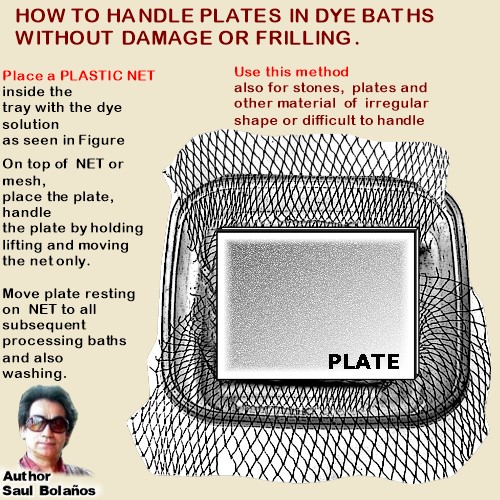 HOW TO HANDLE PLATES
HOW TO HANDLE PLATES
IN DYE BATHS WITHOUT
DAMAGE OR FRILLING.
Place a plastic net inside the tray with the dye solution as seen in Figure.
On top of net or mesh, place the plate,
handle the plate by holding
lifting and moving the net only.
Move plate resting on net to all subsequent processing
baths & also washing.
Use this method also for stones,
plates and other material
of irregular shape or difficult to
handle.
Gold
Sensitization
in the next lessons, it will be seen how this emulsion (my Rapid Negative #7) can be sensitized with gold salts to
attain extreme speeds. Before attempting to gold sensitize this emulsion, it is
assumed that you have already made it several times in previous batches before, and with the gelatine in use, you have
already found its optimum Second Ripening Time, and also weather you need to Sulphur sensitize it or not.
Sodium Carbonate in sensitizer D, must be reduced (as shown below) in order to keep PH of emulsion below 6.5, a PH of
about 6.2 - 6.4 would be furnished by modifying "D" as below ( per every 200 ml of emulsion)
D. Sensitizer solution
add all in one single solution not separately
Sodium Thiosulphate penta hydrate
sol 1: 1000.................... 10 ml
10 % solution Sodium Carbonate
(anhydrous)................... 1- 2 ml
Fresh chicken egg albumen
diluted 1:1 with water.... 20 ml
Success with gold to double or triple speed, depends above all on the type of gelatine used.
1. If the gelatin has great amount of retarders like
Egg Albumen, this may prevent the gold from reaching the silver grain, the result will be no fog, but not much extra
speed either in 1-3 hr /55c ripening time. For this reason it is recommended to test the first batch without the
Albumen given in sol D above.
2. If the gelatine has great amounts of aldehydes, the gold will fog emulsion badly, this may occur in only about 30-60 minutes ripening time, in such case the coated plate ( or paper) will fog very rapidly almost as soon after being immersed in the developer.
If this occurs, The gelatine must be changed for another type. But before changing the gelatine,
It is recommended in such case to add the Egg Albumen to sol D/ above (leave the sodium carbonate and Thiosulphate as usual) in
the hope that it will neutralize part or all of the fogging aldehydes without sequestering the gold salt and rendering
it ineffective.
-Note that the Egg Albumen in D, may be reduced to any amount. It may be found that
less Albumen produces more speed while at the same time checking fog and raising contrast.
It is obvious then, that several tests may be required to find out the optimum ripening time in the presence of gold
salts,
it usually takes the making of several batches or lots of emulsion and once this is known the following Sequence
of Additions will apply: After washing, and melting emulsion as usual in hot water bath, follow sequence of additions
below:
1. Add: D ( first test batch
without the egg albumen, second test batch it may be tried with the albumen)
2. + heat 10m /
55c
3. + add Gold sensitizer
(see below)
4. + Second Ripen for 30min to 3 hr / 55c (optimum
time must be found by trial and error)
5.+ at the end of optimum ripening time in the presence of gold salts, add color sensitizer ( optional)
6.+ hold 5 min / 40- 55c
7. + now you can add stabilizer, ( KBR)
if color sensitized, Nitrobenzimidazole is preferred to kbr, as stabilizer. If Nitrobenzimidazole is not available, and
emulsion is color sensitized, better not to add any stabilizer. Just arrest Ripening when good blacks and high speed
has been reached, but way before the first traces of fog.
8.+ Add Chrome Alum or Potassium Alum as emulsion
hardener
9. + alcohol as coating aid. Note: if color
sensitized a drop in PH is not desired, so Salicylic acid is best to leave out. If kept at or below 10c, Uncoated
liquid emulsion will not biodegrade for 1- 2 weeks.
10.+ adjust water if necessary to final
volume. Refrigerate or coat Finished emulsion.
Gold Sensitizer Stock Solution
Alkali Gold Thiocyanate Solution, keeps well in the dark, under refrigeration.
Ammonium Thiocyanate 1 % Solution: 50 ml
Gold Chloride (AuCL3) 1 % Solution 6 ml
Allow to settle for a while, use clear top part of sol.
just before use Dilute (1:1000) thus:
Above Gold Sensitizer...... 1 part
with water...........................1000 parts
Dosage:
per every 200 ml of Emulsion Or every 10 grams of Silver Nitrate used in Emulsion:
Add: 4 to 8 ml Gold Thiocyanate 1:1000 (as above)
Diluted gold sol should be kept in the dark under refrigeration and preferably used before 3 - 4 weeks. Note: optimum dosage is best found by trial & error Gold may reduce emulsion contrast.
 Using a 1 ML Dropper
Using a 1 ML Dropper
each 1.0 ml = 20 drops
To dilute gold sol 1:1000
with a dropper work as follows:
gold sensitizer:
stock sol as above:........ 1 drop
distilled water: .................50 ml
of the above use: 4-8 ml
per each 200 ml emulsion.
After washing
Divide all the Emulsion in 4 different equal lots, of say, 50 ml each.
To each 50 ml lot add 1- 2 ml of the stock gold sol (1:1000) above.
Ripen at 55c / Lot 1: 30 min. Lot: 2 1 hr, Lot 3: 2 hours Lot 4: 3 hrs. Test each lot, for fog contrast & speed.
Do
this testing in 2 series: one with the albumen and the other without Albumen in sensitizer D

send for
EMULSION FORMULA
not given in this "HTML"
version of this book
NEXT
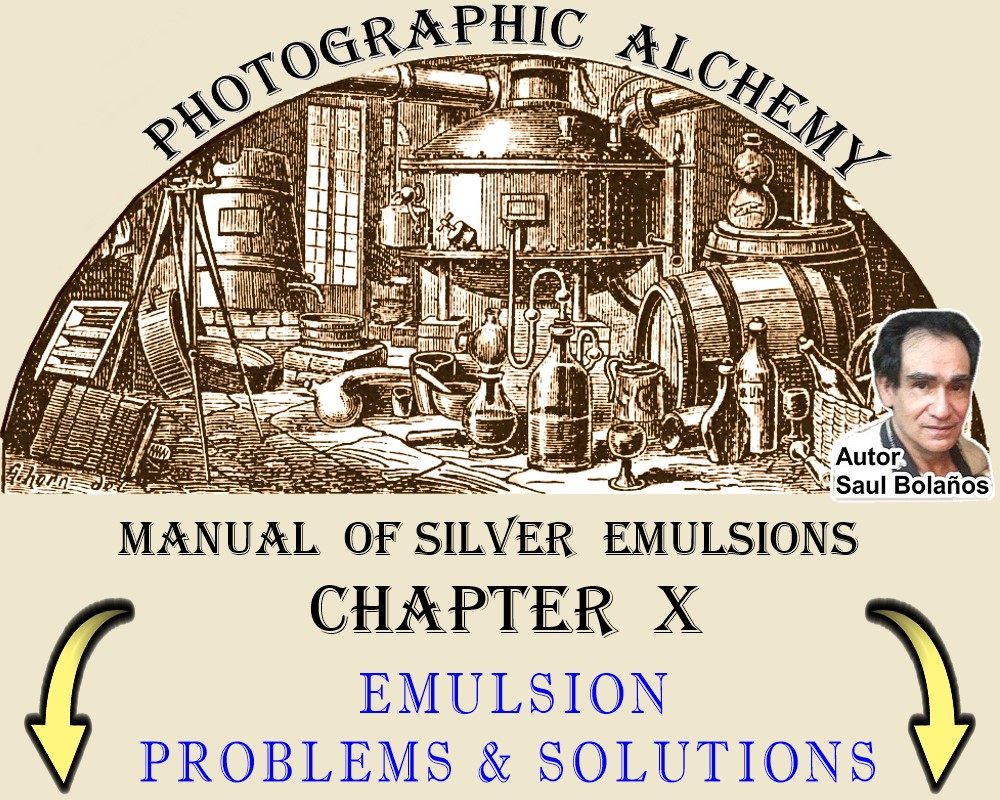
CONTACT

COSTA RICA © 2025, saul bolaños
CAFEDESAUL@GMAIL.COM